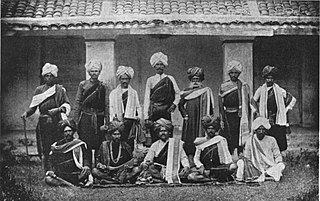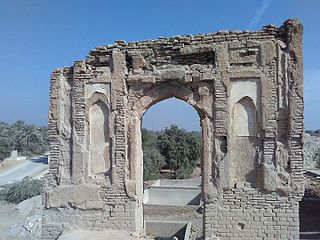Related Research Articles
Telugu Brahmins are Telugu-speaking Brahmin communities native to the Indian states of Andhra Pradesh and Telangana. They fall under the Pancha Dravida Brahmin classification of the Brahmin community in India. Telugu Brahmins are further divided into sections like Vaidiki, Niyogi, Deshastha, Dravida and Golkonda Vyapari.

Vokkaliga is a community, or a group of closely related castes, from the Indian state of Karnataka. They are also present in the neighbouring state of Tamil Nadu.

Karaga is a folk festival of Karnataka which originated as a ritual dedicated to Draupadi as known in these parts as Droupadmma. The ritual is performed on a full moon day.
The Nayak, or Naik is a historic Indian title conferred on military generals and governors of feudal states in the Middle Ages. Today it is also a surname. Nayaks are mostly Hindu and few Sikhs, who follow Hinduism and Sikhism respectively.
Senaithalaivar is a Tamil-speaking caste mainly from south Tamil Nadu.

Aror or Alor or Arorkot is the medieval name of the city of Rohri. Aror once served as the capital of Sindh.
The Bhavsar is a caste found in the Indian states of Gujarat, Maharashtra, Karnataka, Madhya Pradesh, Telangana, Andhra Pradesh, Tamil Nadu and Rajasthan. Their traditional occupation is mainly in business involved in cloth merchant,textile. Early 1850s Bhavsars earn their riches through clothing business, farmlands, havelis, horses but most Bhavsars are now pursuing modern day occupations, including private sector or public sector jobs. After Independence of India Bhavsars did not get much generous govt grants or opportunities. Bhavsars are being considered in general (open) category. With no alternate youth going towards higher education including engineering, medical, business degree and others.
Bengaluru Karaga is an annual festival celebrated in the Halasuru Pete which is also known by Tigalare Pete, primarily by the Vahnikula Kshatriya community. Based on their heritage story, they built temples to Draupadi and Dharmaraya. Adishakti Draupadi is the community Deity of the Vahnikula Kshatriyas, one of the foremost communities in Karanataka state. The Dharmaraya Swamy Temple itself is more than 800 years old. It was built by the Vahnikula Kshatriyas, one of the city's oldest communities that was into agriculture and horticulture. The Karaga festival is generally led by the Vahnikula Kshatriyas. Karaga is one of the many traditions of worshiping Adisakti Draupadi Devi. Karaga pooja and festivals have been celebrated in Tamil Nadu and Karnataka since ages. Its practice is in use in some parts of Kolar district and Bangalore in the state of Karnataka. It is learnt that there are forty lakh people belonging to the Vahnikula Kshatriya community living throughout the state: Hoskote, Malur, Kolar, Bengaluru and Anekal taluks have high populations of the Vahnikula Kshatriya community in both urban and rural areas. Basically, this community depends upon agricultural and horticultural activities.
Kutch Gurjar Kshatriya are a minority Hindu and one of the Socially and Educationally Backward communities of Gujarat in India, who claim to be Kshatriyas. They are an artisan community related with masonry, artistic carvings, sculpting and building and construction works. They are also known as the Mistri or Mistris of Kutch.
Uppara, also known as Sagara, is a Hindu caste predominately found in the Indian states of Andhra Pradesh, Telangana, Karnataka, and Tamil Nadu. They are classified as an Other Backward Class.
The Machhoya Ahir are a gotra of the Ahir found in the Rajkot, Kutch, Junagadh, Amreli, Bhavnagar, Morbi, Jamnagar state of Gujarat in India.
Namadhari is a term used for people of all castes who follow Sri Vaishnava tradition, sport vermillion nama on their foreheads and consider Sri Ramanujacharya as their guru. There are a number of different Namadhari castes like Namadhari Naik in Uttara Kannada, Udupi and Dakshina Kannada Districts, Namdhari Vokkaligas in Malenadu, Namadhari Nagarthas in southern Karnataka and northern Tamil Nadu. and Namadhari Dasari in Andhra Pradesh, Karnataka and Telangana.

The Kunchitigas are a community of people from Karnataka, India. They are mostly concentrated in the Tumkur, Bangalore, Mysore, Ramanagara and Chitradurga districts. They are also found in Tamil Nadu.
The Golla are a Telugu-speaking pastoral community primarily living in the states of Andhra Pradesh and Telangana with smaller numbers in Karnataka and Tamil Nadu. They are related to other pastoral-herding castes like Gulla, Gullar, Gollewar, Gavli and Dhangar and are a part of the larger Yadav community. They are classified as a Backward Caste.
Gowda is a surname native to Karnataka state of India. It is mainly found among the Vokkaligas in South Karnataka and the Lingayats in north Karnataka. It is also used by other communities like Namadhari Naiks, Billavas, Kurubas. Gowda was originally an honorific used by the administrative head of a village. Typically, such a head owned land and held political and social sway in the village. Among Kurubas, it was used to refer to the head of the community.
'Charodi, also referred to as Mestha(Mesta), Chari, Achari, Konkani Achari, Khandekar, or Nayak, is a community from Karnataka state in India.

The Karnataka Tamils are a social community of Tamil language speakers living in Bangalore, capital city of the Indian state of Karnataka and Mysore, Mandya, Kolar Gold Fields, Chamrajnagar, and other districts of old Mysore Kingdom. According to The Hindu newspaper, Tamil-speaking settlers migrated to Bangalore in four major waves, the first after the 10th century; the second during the Vijayanagara period; and the third, in the 18th century, after the need for government service required by British East India Company who built the train tracks in Bangalore. Lastly now most Tamilians move to Bangalore for work. However some may say both kannadiga and Tamil were there from the first. According to census 1991, people speaking Tamil as mother tongue in Bangalore formed about 21%. There are 2.1 million Tamils living in Karnataka as of 2011 Census report.
Sembadavar or Parvatha Rajakulam is a traditional fisherman community found mainly on the Coromandel coast of the Indian states of Tamil Nadu and Pondicherry. They also take the title Nattar. Sembadavar are a maritime community who are occupied primarily as inland and river fishermen and primarily fish with fishing net. A similar caste also known as Sambuni Reddi is found in Andhra Pradesh and Telangana. There are many theories as to their origins but they have since ancient times been recorded in the area of Tamil Nadu, Pondicherry and Sri Lanka.
The Kaikadi are a community found in the Indian states of Maharashtra and Karnataka. their name derived from kai and kade, while the community derives its name from kai and kadi. Traditionally they were nomadic, mainly wandering in the Vidarbha region of the state, but most have now settled down. They speak Kaikadi, a Dravidian language closely related to Tamil with significant Indo-Aryan admixture.They practice the puberty function like other Tamil communities.
Varu is a surname of Indian origin, found among the people from Kutch and Saurashtra regions in the state of Gujarat in India and diaspora of people of India. Outside India, Varu surname occurs in people of United Kingdom, Papua New Guinea, Cook Islands & Canada.
References
- 1 2 Singh, Kumar Suresh; India, Anthropological Survey of (2003). People of India. Anthropological Survey of India. ISBN 9788185938981.
- http://www.ncbc.nic.in/Writereaddata/cl/karnataka.pdf - ↑ Karnataka State Gazetteer: Bangalore District. Director of Print., Stationery and Publications at the Government Press. 1990. p. 173.
- ↑ Kamath, Suryanath U. (1996). A Handbook of Karnataka. Government of Karnataka, Karnataka Gazetteer Department.
- ↑ Kumar Suresh Singh (2003). People of India. Anthropological Survey of India. ISBN 9788185938981 – via Google Books.